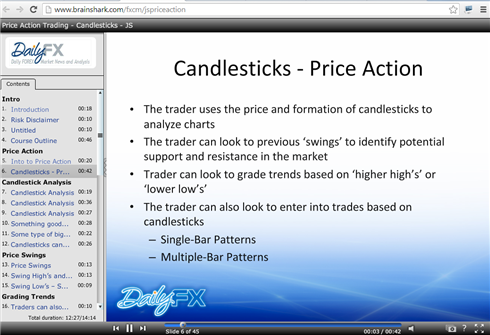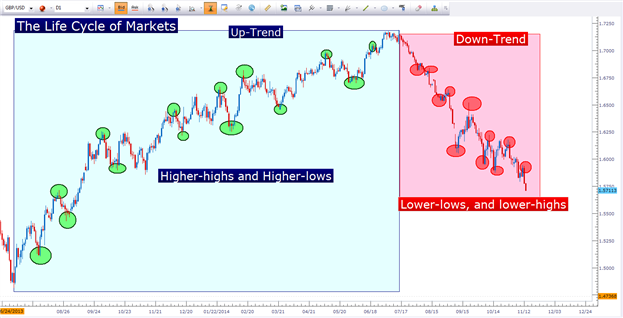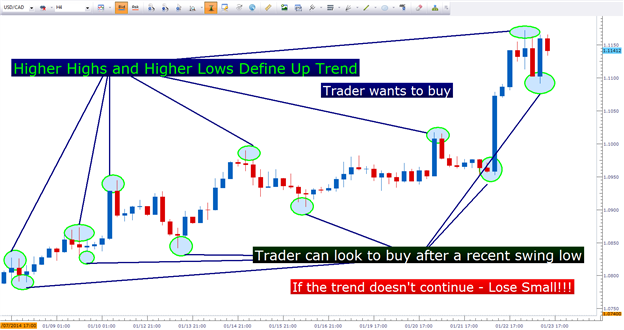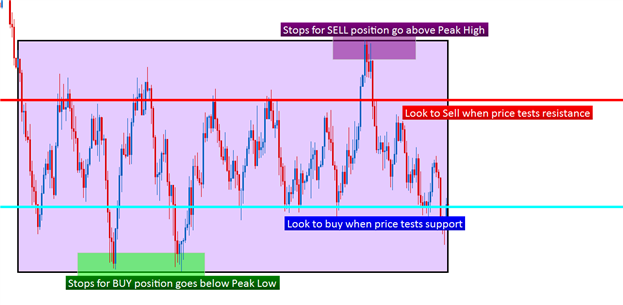How to Set Risk Amounts with Price Action
by
, 11-29-2014 at 05:42 PM (1440 Views)
- Traders should look for biases (trends) in the effort of getting the probabilities of success on their side, if even just by a little bit.
- There is a massive difference between trading and analysis, and risk management can assist in bridging that gap.
- Price action can offer traders built-in methods for managing and setting risk based on the environment in which they’re trading.
Technical analysis is to use what’s happened in the past in the effort to trade what may happen in the future, it only reasons that traders should look to trade with the most accurate information available.
How to Form a Bias with Price Action
There are numerous ways to form a bias in a market. Many traders like the use news and current events. I wish I could call this ‘fundamental analysis,’ but it really isn’t. This is chasing the ‘hot dot,’ which isn’t too dissimilar from choosing to drive during the heat of rush hour, or attempting to get actual shopping done during ‘black Friday.’ Fundamental analysis is considerably more in-depth than just reading a newspaper or an article to form an opinion on a matter (or a market).
Traders that are actually using fundamental analysis are looking inside of an economy at data points that may show signs of growth or contraction. This process requires analysis of data sets like the Consumer Price Index, or Gross Domestic Product over long periods-of-time in the effort of seeing ‘inside of the economy.’ The hope here is that all of this data analysis will point to a key variable that will often drive Foreign-Exchange prices, and that is Interest Rates.
In a normal environment, higher rates attract capital. Lower rates cause capital to flee. This is just logic. If all factors (and risks) are equal and you can choose between an investment paying 5% and another paying 3%, rationally investors should choose the 5% option. Of course there are outlier situations, such as the Financial Collapse in which investors may prefer lower-yielding investments (such as US Dollars), simply because of the relative safety that can be had in such instruments.
This highlights an inherent difficulty with fundamental analysis: You can be 100% right in your analysis, but you can still lose a lot money. This goes right back to that old quote of ‘the market is always right.’
The goal of the fundamental analyst is to find unrealized value in the market: An inherent contrarian-like strategy. And just as John Maynard Keynes had said, ‘The market can remain irrational far longer than you or I can remain solvent.’
So does this mean fundamental analysis should be avoided because it will, at times, be wrong? Not necessarily… it simply means that traders need to incorporate this information in an efficient fashion; taking fundamental analysis as more of a hypothesis or idea than a scientific law. But there has to be a better way of generating a bias than simply reading newspapers or digging through old CPI reports.
Price action can be hugely helpful here. By looking at current price and its relationship to past prices, we can see the way that the market is evaluating an investment at any one point-in-time. There’s no projection needed here… no prognostication. Price action is real, actual prices that have traded in the market, and we don’t have to examine each movement to decide whether or not its ‘real,’ because it’s all real.
Up and Down Trends shown via Price Action (GBPUSD Daily Chart)
To form a bias with price action, traders can evaluate a longer-term, bigger-picture chart of that market in the effort of seeing whatever prevailing bias may impact their targeted time frame. This is incorporating multiple time frame analysis in the effort of getting the most complete picture of a market. So, if you’re looking to enter positions on the hourly chart, look to the 4-hour chart for prevailing trends so that when you trigger positions on the hourly, you can do so in the direction of whatever prevailing bias has been seen.
Setting Risk with Price Action
A consistent theme throughout our price action articles is the necessity of risk management. And the reason that I’m so ardent around the topic is because over the long-term, risk management is the factor that often leads to a trader’s success or demise.
Just as we encountered in the previous section, the difficult aspect of analysis is that you can be 100% spot-on in your analysis yet still lose money. As a trader, your success is based solely on one factor: Are you profitable?
Many traders, especially new ones, delude themselves into thinking that analysis and trading one in the same. This can be a disastrous and ill-informed vantage point.
Surely, analysis can help a trader… and over a long enough time horizon, if one trades well (profitably) long enough, they’re bound to learn at least some analysis. But success as a trader is about a lot more than just guessing based on a hunch, and hoping that it might work out.
Again – they were right well over half the time, but still lost money. And this isn’t some anecdotal assertion, nor am I asking you to just take my word for it: This was data generated over 12 million trades placed by real traders like you and I with the goal of making money on a market.
Without proper risk management, all of the great analysis in the world can be rendered moot.
So manage your risk before it manages you.
If a trader is looking to buy in a trend, then the market has shown a series of ‘higher-highs’ and ‘higher-lows,’ as that bias has been priced in the market. So, if one is going to look to buy in that trend, and this process of higher-highs and higher-lows does not continue, why would they want to stick around in the trade? What they’ve seen (and what they’re looking for) – continuation of the trend – comes in question as soon as ‘lower-lows’ or ‘lower-highs,’ come into the market – so why wait around to see how wrong you might’ve been?
If buying an up-trend, why stay in the trade if lower-lows are made?
If a trader is looking to buy in a range-bound market, anticipating that prices may move back up to previously-defined resistance; it would be logical to look to bail out of the trade if a lower-low was made, right? After all, if a lower-low is made, that means that support has been broken… and if support breaks whilst in a long position, how do we know that this breakout won’t continue to the down-side? And if this breakout does continue to the downside while the range-trader sits in a long position, a considerable amount of equity can be lost in a very short period of time.
If trading a range, why stay in the trade if the range breaks out against your position?
When trading a range, traders can use price action to place their stops slightly below support (for long positions – or above resistance for short position), so that if/when the range breaks, the trader is protected from taking an outsized loss on the position.
A Final Note
While there is no analysis in the world that’s a panacea with the ability to solve the ultimate question (where future prices will move); price action can present a clean analytical framework with which traders can approach a market with a logical and well-thought out approach.
Traders need to keep the number one goal in mind – which should, as a trader, be to make money. And while performing analysis can be fun, and might make us feel good when we’re right – we have to remember that this is only a small portion of the approach.
Trading is about technique… trading is about risk management… and trading is about knowing what to do when your analysis doesn’t pan out as you had hoped, because every trader in the world is going to find themselves in that situation. This is when we should prioritize loss mitigation over profit maximization.
--- Written by James Stanley
More...
















 Email Blog Entry
Email Blog Entry